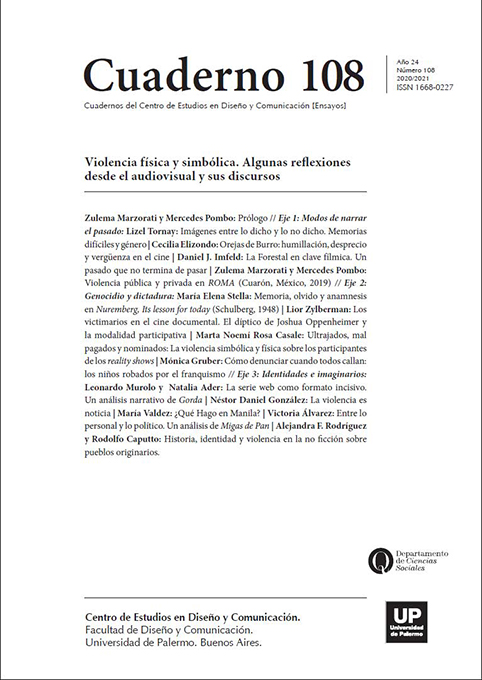Los victimarios en el cine documental. El díptico de Joshua Oppenheimer y la modalidad participativa
Abstract
This article is part of an investigation about the representation of genocides in documentary cinema, in this instance I will be discuss about how the memory of the perpetrators has been presented. To do this, some background and problems about the subject will first be briefly reviewed; secondly, I will comment the representation strategies employed that I suggest to analyze the representation of the perpetrators; finally, I will focus on the participatory mode trough the analysis of the documentaries The Act of Killing (Joshua Oppenheimer, 2012) and The Look of Silence (Joshua Oppenheimer, 2014). There, in addition to think about the characteristics of this modality, we will analyze the memory that this strategy allows to set in motion.
References
Adams, J., & Vice, S. (Eds ). (2013). Representing Perpetrators in Holocaust Literature and Film. Vallentine Mitchell.
Baddeley, A., Eysenck, M., & Anderson, M. (2018). Memoria. Alianza Editorial.
Brink, J., & Oppenheimer, J. (2013). Killer Images: Documentary Film, Memory and the Performance of Violence. Columbia University Press.
Browning, C. (2011). Aquellos hombres grises. El batallón 101 y la solución final en Polonia. Edhasa.
Bruzzi, S. (2006). New Documentary. Routledge.
Chalk, F., & Jonassohn, K. (2010). Historia y sociología del genocidio. Prometeo.
Collingwood, R. G. (1952). Idea de la Historia. Fondo de Cultura Económica. de Swaan, A. (2015). The Killing Compartments. The Mentality of Mass Murder. Yale University Press.
El-Hai, J. (2015). El nazi y el psiquiatra. Ariel.
Fraser, N. (2013). We Love Impunity: The Case of The Act of Killing. Film Quarterly, 67(2), 21-24. https://doi.org/10.1525/fq.2014.67.2.21
Fraser, N. (2014). The Act of Killing: Don’t give an Oscar to this snuff movie. https://www.theguardian.com/commentisfree/2014/feb/23/act-of-killing-dont-give-oscar-snuffmovie-indonesia
Hatzfeld, J. (2004). Una temporada de machetes. Anagrama.
Jablonka, I. (2017). Nueva memoria para una nueva historia. En I. Jablonka & A. Wieviorka (Eds.), Nuevas perspectivas sobre la Shoá. Universidad Nacional de Quilmes Editorial.
LaCapra, D. (2005). Escribir la historia, escribir el trauma. Nueva Visión.
Lanzmann, C. (2011). La liebre de la Patagonia. Seix Barral.
Metz, J. (2012). Reading the victimizer: Towards an ethical practice of figuring the traumatic moment in Holocaust literature. Textual Practice, 26 (6), 1021-1043. https://doi.org/10.1080/0950236X.2012.727016
Oppenheimer, J. (2012). Perpetrators’ Testimony and the Restoration of Humanity: S21, Rithy Panh. En Joram ten Brink & J. Oppenheimer (Eds.), Killer Images. Documentary Film, Memory and the Performance of Violence. Wallflower.
Oppenheimer, J., & Uwemedimo, M. (2012). Show of Force. A cinema‐séance of power and Violence in Sumatra’s plantation belt. En J. Oppenheimer & J. ten Brink (Eds.), Killer Images. Documentary Film, Memory and the Performance of Violence (pp. 287-310). Wallflower. https://onlinelibrary.wiley.com/doi/abs/10.1111/j.1467-8705.2009.01851.x
Panh, R., & Bataille, C. (2013). La eliminación. Anagrama.
Plantinga, C. (2009). The Philosophy of Errol Morris: Ten Lessons. En W. Rothman (Ed.), Three Documentary Filmmakers. Errol Morris, Ross McElwee, Jean Rouch. SUNY.
Robinson, G. (2018). The Killing Season. Princeton University Press.
Roosa, J. (2006). Pretext for Mass Murder. The September 30th Movement and Suharto’s Coup d’État in Indonesia. The University of Wisconsin Press. Taylor, C. (2006). Imaginarios sociales modernos.
Paidós. Waller, J. (2007). Becoming Evil. How Ordinary People Commit Genocide and Mass Killing. Oxford University Press.
Wieviorka, A. (2006). The Era of Witness. Cornell University Press.
Williams, T., & Buckley-Zistel, S. (Eds.). (2018). Perpetrators and Perpetration of Mass Violence. Action, Motivations and Dynamics. Routledge.
Winston, B. (1988). The Tradition of the Victim in Griersonian Documentary. En A. Rosenthal (Ed.), New Challenges for Documentary (pp. 269-287). University of California Press.
Zimbardo, P. (2008). El efecto Lucifer. Paidós.
Zylberman, L. (2015). ¿Una película sobre el olvido? Sobre The act of killing de Joshua Oppenheimer. TOMA UNO, 4, 57-70.
Zylberman, L. (2016). Una aproximación a la construcción del mal en el díptico documental de Joshua Oppenheimer sobre Indonesia. Cuadernos de Marte, 0(10), 149-172.
Zylberman, L. (2018). Cine Documental y Genocidio: Hacia un abordaje integral. Significação: Revista de Cultura Audiovisual, 45(50), 223-238. https://doi.org/10.11606/issn.2316-7114.sig.2018.144075
Los autores/as que publiquen en esta revista ceden los derechos de autor y de publicación a "Cuadernos del Centro de Estudios de Diseño y Comunicación", Aceptando el registro de su trabajo bajo una licencia de atribución de Creative Commons, que permite a terceros utilizar lo publicado siempre que de el crédito pertinente a los autores y a esta revista.


